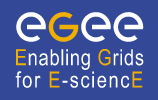
Harnessing grid computing to save women’s lives
Breast cancer is the most common cancer in women. In the EU and the US, one in eight will develop it at some point in their lives, and it will kill one in 28. But harnessing the power of the grid could help increase the accuracy of diagnoses
Mammography examinations save thousands of women’s lives every year. However the rate of misdiagnosis can be high – in some instances up to 30%. This is due in part to physical differences across patient populations, differences in equipment and procedures, and difficulty in using computers to help detect changes in breast tissue.
Computer-aided detection of this potentially fatal cancer, especially when used together with the traditional method of visually screening mammograms, can not only shorten the time needed for analysis, but can also help increase the accuracy of diagnoses.
Novel approach to comparative diagnoses
The team in the European IST project MammoGrid, which ended in August 2005, aimed to apply the power of the grid to see if they could more accurately detect breast cancer. The prototype software that resulted is already enabling users – hospitals, doctors, clinicians, radiologists and researchers – to harness the massive capacity of grid computing to run advanced algorithms on digital mammograms, stored Europe-wide.
The project team also developed a geographically distributed, grid-based database of standardised images and associated patient data. Already, there are 30,000 images stored from over 3,000 patients, equally balanced between the University Hospital of Cambridge in the UK and Udine in Italy.
The novelty of the MammoGrid approach lies in the application of grid technologies to medical diagnoses, and in providing the data and tools to enable users to compare new mammograms with existing ones in the grid database. Users can access mammograms from a variety of sources, and also computer-aided detection algorithms to detect micro-calcifications (tiny specks of calcium in the breast that could indicate cancer) and monitor breast density (dense tissue is considered a major risk factor).
Comparative analysis of mammography images can improve diagnoses
Sharing resources and patient data
“The system in its current version allows users to securely share both resources and patient data which has been treated to ensure anonymity,” explains project coordinator David Manset of Maat GKnowledge in Madrid, Spain. “It also supports effective co-working and provides the means for powerful comparative analyses through the use of a standard format for mammogram images”.
This break-through functionality could lead to major advances in prevention and detection of the disease. It also opens the door to novel, broad-based statistical analyses of the incidence of breast cancer and its different forms.
MammoGrid+ building on the achievements
Since the project ended, a new consortium independent of IST funding has been set up to further develop the prototype and take it closer to market needs. Under Mammogrid+, a new set of partners (including organisations such as CIEMAT (Spain’s Energy, Environmental and Technological Research Centre), CERN (Switzerland), SES (health service for the Extremadura region of Spain, representing the hospitals of Infanta Christina, Don Benito and Merida), and the university hospitals of Cambridge and Udine) is building on the results already achieved.
The new project team has set up four separate sites, to simulate the needs of four different hospitals and test the latest project developments. The results from these tests have been evaluated by a panel of two IT experts and five clinicians from the hospitals in Spain’s Extremadura region.
Their feedback is being incorporated into a pre-commercial release of the software (Mammogrid+ version 1.0) in June 2007. This version is being deployed within the five hospitals collaborating in the project – these hospitals will also receive the hardware infrastructure to host the Mammogrid+ suite.
Future plans include broadening the existing database Europe-wide. Already a further hospital, the university hospital of Cork in Ireland, has shown interest in joining the Mammogrid+ network.
“The inclusion of the new hospitals will increase the coverage of the database and make our knowledge more relevant and more accurate," Manset concludes. "This will allow larger and more refined epidemiological studies. In the end, these techniques could help save lives.”
Contact:
David Manset
Maat GKnowledge
Calle San Bernardo num 115, 5 izq
E-28015 Madrid
Spain
Tel: +34 68 780 2661
Fax: +34 67 347 9175
Email: dmanset@maat-g.com
Source: Based on information from MammoGrid
Latest News
Business News from around the World! The business benefits of e-Infrastructures and related technologies were the focus of the dedicated Business Track within the BELIEF-EELA Conference taking place this week in Rio de Janeiro, Brazil, where EGEE presented its Programme for Industry.
... Read moreTechnical sites
Try the GRID
Become a User
Want to become a user of the EGEE Grid? Click here
Related Projects
If your project is related to EGEE, please register it
Information Sheets
Click here for all the EGEE Information Sheets.
Contact EGEE
Get in touch with the EGEE Project Office at .
If you have questions about the Website contact: .
If you have questions about the Website contact: .

